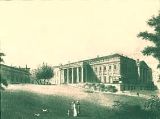
Palais Rasumofsky
Encyclopedia

Palais Rasumofsky is a palace
Palace
A palace is a grand residence, especially a royal residence or the home of a head of state or some other high-ranking dignitary, such as a bishop or archbishop. The word itself is derived from the Latin name Palātium, for Palatine Hill, one of the seven hills in Rome. In many parts of Europe, the...
in Vienna
Vienna
Vienna is the capital and largest city of the Republic of Austria and one of the nine states of Austria. Vienna is Austria's primary city, with a population of about 1.723 million , and is by far the largest city in Austria, as well as its cultural, economic, and political centre...
, Austria
Austria
Austria , officially the Republic of Austria , is a landlocked country of roughly 8.4 million people in Central Europe. It is bordered by the Czech Republic and Germany to the north, Slovakia and Hungary to the east, Slovenia and Italy to the south, and Switzerland and Liechtenstein to the...
.
The palace was commissioned by Prince Andrey Kyrillovich Razumovsky as a Neoclassic
Neoclassicism
Neoclassicism is the name given to Western movements in the decorative and visual arts, literature, theatre, music, and architecture that draw inspiration from the "classical" art and culture of Ancient Greece or Ancient Rome...
embassy worthy of the representative of Alexander I
Alexander I of Russia
Alexander I of Russia , served as Emperor of Russia from 23 March 1801 to 1 December 1825 and the first Russian King of Poland from 1815 to 1825. He was also the first Russian Grand Duke of Finland and Lithuania....
. It was built at the prince's own expense and to the designs of Louis Montoyer
Louis Montoyer
Louis Montoyer was an 18th century Belgian-Austrian architect, principally active in Brussels and Vienna.-Life:...
, in Landstraße
Landstraße
Landstraße is the 3rd municipal District of Vienna, Austria] . It is near the center of Vienna and was established in the 19th century. Landstraße is a heavily populated urban area with many workers and residential homes. It has inhabitants in an area of 7.42 km². It has existed since...
, close to the city center of Vienna. He filled it with antiquities and modern works of art. On New Year's Eve
New Year's Eve
New Year's Eve is observed annually on December 31, the final day of any given year in the Gregorian calendar. In modern societies, New Year's Eve is often celebrated at social gatherings, during which participants dance, eat, consume alcoholic beverages, and watch or light fireworks to mark the...
1814, the prince held a glittering ball with the new Tsar Nicholas I
Nicholas I of Russia
Nicholas I , was the Emperor of Russia from 1825 until 1855, known as one of the most reactionary of the Russian monarchs. On the eve of his death, the Russian Empire reached its historical zenith spanning over 20 million square kilometers...
as guest of honour. Probably the only person in Vienna who was invited but did not go, was Ludwig van Beethoven
Ludwig van Beethoven
Ludwig van Beethoven was a German composer and pianist. A crucial figure in the transition between the Classical and Romantic eras in Western art music, he remains one of the most famous and influential composers of all time.Born in Bonn, then the capital of the Electorate of Cologne and part of...
. To accommodate the guests, Razumovsky erected a temporary ballroom extension, heated by a flue
Flue
A flue is a duct, pipe, or chimney for conveying exhaust gases from a fireplace, furnace, water heater, boiler, or generator to the outdoors. In the United States, they are also known as vents and for boilers as breeching for water heaters and modern furnaces...
from the palace. After all the guests had gone, the flue caught fire, setting the ballroom ablaze and burning out roomfuls of art in the palace. Rasumovsky, though he was raised to Prince the following year, was never the same. He lived in seclusion in Vienna until his death in 1836.

